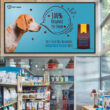In times of adversity, innovation becomes the cornerstone of survival for businesses. The pandemic era bore witness to numerous establishments pivoting to unconventional solutions—hotels transformed empty rooms into co-working spaces, restaurants embraced takeaway menus, and retailers, in a strategic move, birthed the concept of “dark stores” to cater to an audience confined indoors.

Despite economic challenges and income contractions for many, the retail sector experienced a surprising surge, boasting a 35% increase in market capitalization from February 2020 to April 2021. However, the road to success during the pandemic was not uniform, and McKinsey points out that companies with tech-forward and asset-light models, driven by the tailwinds of growing demand, outshone their industry peers.
What is a Dark Store?
A dark store represents a traditional brick-and-mortar location repurposed into a fulfillment center, closed to in-person shoppers. This transformation facilitates efficient order fulfillment, offering options like online purchasing, same-day delivery, or in-store pickup.
While variations of this concept were not novel—with giants like Whole Foods, Walmart, Target, and others having experimented with similar models—the pandemic prompted a significant increase in the number of dark stores as traditional retailers sought innovative solutions during lockdowns.
How Does Dark Store Order Fulfillment Work?
Dark stores offer three primary delivery options:
Curbside Pickup: Designated parking spaces facilitate order handover to customers in their vehicles, ensuring safety during the pandemic and providing a convenient shopping experience.
In-Store Pickup: Dark stores may feature dedicated pickup areas inside, allowing customers to collect orders without navigating through the entire store. This option reduces delivery expenses and enhances convenience.
Home Delivery: The surge in demand for home delivery, especially during the pandemic, aligns seamlessly with the capabilities of dark stores. This option ensures swift and contactless delivery, ideal for groceries and essential items.
Benefits of the Dark Store Concept
1. Quick and Contact-Free Shopping
The emphasis on social distancing and safety measures necessitated contact-free shopping. Dark stores met this demand, allowing consumers to make purchases without physically entering the retail space—offering online shopping safety with nearly instant gratification.
2. Improved Distribution and Quicker Delivery
Dark stores expedite order fulfillment by providing various distribution options and physically bringing products closer to specific markets. This efficiency results in faster and more reliable delivery.
3. Larger Audience and Broader Reach
Transforming a brick-and-mortar store into a dark store expands the potential audience, making products accessible online 24/7.
4. Improved SKU Management
Dark stores, especially beneficial for grocery retailers (termed “dark supermarkets”), enhance stock keeping unit (SKU) management by focusing on storage and click-and-collect capabilities.
5. Easier to Manage Perishable Products
The concept of dark stores addresses the challenge of perishability, crucial for delivering fresh food with efficient warehouse control and order fulfillment.
6. More Extensive Range of Products
Optimized layouts of dark stores, tailored for enhanced storage and picking capabilities, allow for a more extensive product assortment.
7. Improved Inventory Control and Management
Some dark stores serve as fulfillment centers supporting multiple stores in a geographic region. Being customer-free zones, these warehouses offer better control over inventory and facilitate managing larger order volumes.
Have Dark Stores Remained Relevant After the Pandemic?
While the concept of dark stores predates the pandemic, its adoption witnessed exponential growth during lockdowns. The sustained demand for e-commerce, curbside pickup, and instant delivery indicates that dark stores are not just a temporary solution but an evolving retail model.
Retailers acknowledging and adapting to ongoing shifts in consumer behavior are poised to win the loyalty of future customers. Dark stores offer a dynamic and versatile approach to retail, aligning seamlessly with the digital transformation of shopping habits.
Does the Dark Store Model Work for All Businesses?
As lockdowns become history, businesses need to evaluate the necessity of physical stores. Considering visitor frequency to each location, brands may choose to retain a flagship location in a major city.
Dark stores, depending on their location, may pose challenges in providing same-day or same-hour delivery. However, aligning with customer expectations and considering the nature of the products, not all deliveries require expedited services.
Certain stores can operate as micro-fulfillment centers for last-mile fulfillment and pickups, adding purpose to physical stores beyond foot traffic dependence. This shift pushes businesses toward omnichannel strategies and enhanced digital capabilities.
Key Takeaways
The pandemic accelerated the ongoing shift from brick-and-mortar stores to online shopping, permanently reshaping the retail landscape. Brands must adapt to this evolution to stay relevant. Closing some locations and transforming them into dark stores emerges as a strategic move.
Benefits of dark stores include quick and contact-free shopping, improved distribution, broader audience reach, enhanced SKU management, easier perishable product management, an extensive range of products, and improved inventory control.
As the retail sector continues to embrace change, dark stores remain a pivotal element in the $6.5 trillion e-commerce landscape projected for 2023. In the realm of retail, innovation is not just an option—it’s a necessity for survival and success.
Have an e-commerce mobile app idea that you would like to build? eddress can definitely help you!
Visit our website and let’s get on a call!
For more content like this, visit our blog!







